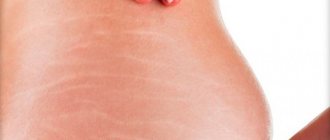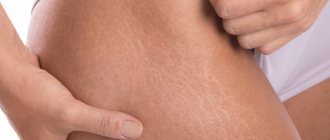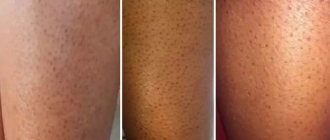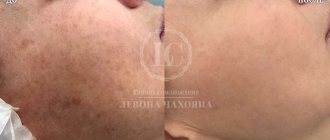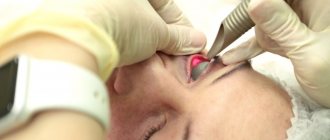- carrying twins, triplets or a large fetus. The skin of the abdomen is greatly stretched and torn;
- obesity or excessive weight gain during pregnancy. General weight gain provokes stretch marks on different parts of the body, including legs and buttocks;
- polyhydramnios. An increased amount of amniotic fluid is the cause of a large volume of the abdomen, and as a result, stretch marks on it;
- weakness of the abdominal muscles. The absence of a muscle corset reduces the elasticity of the skin;
- dry skin. Insufficient hydration provokes the risk of micro-tears and reduces the protective function of the skin.
Women with diabetes and other endocrine disorders are at high risk of various disorders, including stretch marks during pregnancy. Typically, stretch marks appear after 20–24 weeks, but in some cases they are possible in the early stages.
How to prevent stretch marks during pregnancy
Avoiding stretch marks during pregnancy is easier than dealing with them. It is better to carry out prevention from the early months of pregnancy.
What will help prevent stretch marks:
- Maintain muscle tone. Moderate physical activity and light massage, for example, with a washcloth or dry brush, are useful. Blood circulation improves, skin elasticity increases;
- Moisturize the skin. Use oils and special body creams. You can rub olive, orange, or grape seed oil into the skin. This creates a protective layer that prevents microtraumas;
- Eat properly. Protein foods, as well as eating foods rich in vitamin E (vegetable oil, nuts, spinach) help increase skin elasticity;
- Wear special underwear. Maternity bras and bandages support the body, reduce the likelihood of sagging skin and the appearance of stretch marks during pregnancy.
If you can no longer avoid the problem, you should choose gentle methods that will help remove stretch marks.
Why do stretch marks occur?
There may be several reasons for the occurrence of stretch marks, or stretch marks, but the main one is insufficient cell regeneration. When the volume of the abdomen increases, there are not enough cells. They do not have time to share in the required quantity, which is why the surface of the epidermis becomes thinner.
The thin layer of epidermis in itself is not a stretch mark. But the area of the body with this problem is impacted: a sudden movement, a pulled muscle, an awkward turn - the weak epidermis is torn and micro-tears appear.
The body strives to “patch” them as quickly as possible. New tissue is born, but, alas, not like healthy skin, but scar tissue. Below it, processes associated with injury occur: torn capillaries give the striae red, like a cut, then lilac and violet colors. Over time, the internal damage heals and only a white stretch remains, similar to a scar. It cannot be hidden under any tan: unlike healthy cells, scar cells do not react to ultraviolet radiation.
Other causes of stretch marks may include::
- Poor nutrition : During pregnancy, the body especially needs vitamins. Without fresh vegetables and fruits, protein, complexes of groups B, C and D, cells do not receive what they need, so they become less elastic. This increases the risk of microtears in the tissue, even if the cells themselves are still sufficient to maintain the required thickness of the epidermis.
- Excess or lack of physical activity . With fanatical exercise, as well as with the wrong selection of exercises, the muscles are under constant stress. The epidermis becomes thinner and tears. For healthy fitness, taking a day or two off after a workout is recommended. This way the muscles remain toned, but at the same time have time to relax. With a sedentary lifestyle, muscles, on the contrary, atrophy. The skin becomes loose and loses elasticity because sluggish blood flow does not deliver enough oxygen.
- Hormonal disbalance . The body prepares for childbirth and produces progesterone, a hormone that relaxes the uterus and along with it the rest of the muscles and connective tissues. Due to loss of tone, the epidermis is easily torn.
- Smoking and alcohol . There are obvious reasons why the skin of an ordinary person deteriorates. Alcohol and nicotine interfere with the production of elastin and collagen - substances responsible for skin elasticity.
- Early or late age of a woman . By the age of 18, the body is not ready for the hardships of pregnancy, and after 30 years, not enough collagen is produced.
- Repeated births . It takes 2 years for the body to recover. Before this period, hormonal levels will not have time to improve, and time is also needed to replenish vitamin reserves and put your figure in order.
- Feeding _ The lactation period is a very heavy burden for the breasts. To avoid stretch marks, you will need bandages and special underwear, as well as stretch mark cream. However, before using a cosmetic product, make sure that it can be used during lactation.
- Having obesity or diabetes . The body is already functioning beyond normal limits, and in the case of diabetes there are even disturbances in the endocrine system.
- Heredity is more of a risk factor than a cause. But it also needs to be taken into account. If your mother and grandmother had stretch marks, most likely you will have them too.
Knowing the reasons for their appearance, you can avoid stretch marks simply by taking precautions in time. If stretch marks do occur, it is possible to get rid of them. The main thing is to choose the right method of treatment and not to cause stretch marks - young colored stretch marks are easier to cure than old white ones.
How to get rid of stretch marks during pregnancy
Dealing with the problem is not easy, since the skin is already damaged. But you can make stretch marks look less noticeable. You can remove unaesthetic manifestations using the following methods:
If stretch marks are already old, then superficial methods cannot get rid of them. If you have the means and opportunities, you can do laser peeling or resort to the excision method. But such methods are undesirable during pregnancy. It is better to take care of your skin in advance and try not to gain too much weight, and use a washcloth more often to exfoliate your skin. But even if the problem appears, do not despair - over time, the stretch marks will become pale and almost invisible.
Do stretch marks tan?
This question is asked by many pregnant and non-pregnant women. Because everyone wants to disguise these flaws and look their best. But we will disappoint you: stretch marks (striae) cannot tan. The explanation is that in the connective tissue from which scars are formed, there is no pigment called “melanin”.
You may also notice that after spending many hours in the sun, the stretch marks become even more noticeable because the underlying skin has become darker, but the stretch marks remain white or light.
Oil massage at home
Some ladies do not trust the remedies for stretch marks that are sold in stores. Therefore, you can use home remedies. You can use oils for massage:
- sea buckthorn
- olive
- almond
- peach, etc.
They contain vitamin E, which is known to have a beneficial effect on the skin's ability to stretch without tearing. The oil can be slightly warmed up (for example, placed on a radiator) and rubbed into problem areas after you have taken a bath. You can also rub in the oils after the scrub, the recipe for which is described above.
Some beauty and skin experts advise adding essential oils to the base oils (named above) at your discretion. But we do not recommend such experiments. Because you cannot predict your body’s reaction to the oil and its effect on the fetus. Serious allergic reactions are possible, even angioedema, the outcome of which is often fatal. If you were a fan of aromatherapy before conception, you should put this hobby aside while you are pregnant. Safety comes first!
Gymnastics for pregnant women
Before performing any exercises or practices, you should consult your obstetrician-gynecologist. Each case is individual. What suited your neighbor who gave birth may not suit you at all. An adequate doctor (in the absence of serious pathologies) will help you choose a suitable sports complex. Complete passivity is recommended in extremely rare cases when the pregnant woman and the unborn baby have serious problems.
Remember that activity should be different in all trimesters. The reason is that some of the exercises that can be done in the first three months later become uncomfortable and even dangerous. Pregnant women should not do abdominal exercises, jumping, and weight training equipment is not recommended.
If you experience discomfort while doing exercises, or your pulse cannot “calm down,” then stop exercising immediately. Don’t rush to do all the exercises at once and in large quantities. If you were quite passive before conception, then you need to start with minimal loads.
Positional gymnastics for pregnant women
These exercises help prepare a woman's muscles for the process of childbirth, and will also help you feel more comfortable during childbirth by training specific muscles.
- “cat” pose: stand on all fours, round your back, lowering your head as low as possible, and then arch your back, raising your head while looking up (do everything smoothly and while breathing)
- “butterfly” pose: sit on the floor, pull your legs towards you on the floor and put your feet together (knees bent), put your hands on your knees. Use your palms to gently press on your knees so that the inner thighs stretch. Do not apply pressure to the point of pain, there should only be tension.
- twists: sit or stand; turn the body in one direction and the other, opening your arms in the same direction, while the pelvis does not rotate, it “looks” forward
- Kegel exercises: good for the perineal muscles; try to tense your muscles as if you want to block the flow of urine, and then relax them.
Fitball for pregnant women
This technique is no less effective than the one described above. It just has a different technique at its core. In the first 3 months of pregnancy, minimize stress. If you did not engage in dancing, yoga, sports or physical education before conception, start classes only from the 4th month of pregnancy. We will not describe exercises for the arms here, because stretch marks on them are extremely rare. Let's start with chest exercises .
- We sit on the floor, folding our legs in Turkish style, and take a fitball. Our arms are bent, elbows “look” to the sides. We begin to press the fitball with our palms and do 10-15 repetitions. Breathing should be smooth, without delays
- We sit on the ball and hold dumbbells in our hands. Bend your arms at an angle of 90˚ in front of your chest at the same level. We don’t extend our arms, but take them to the sides, and then bring them together again. As in the previous exercise, do 10 to 15 repetitions
Exercises for legs and buttocks:
- lie on your back, bend your right leg and place your foot on the ball. We also bend the left one and place it on the floor. We straighten our right leg and roll the ball forward, and then bend it again, returning it to the starting position. You can also make circular movements with your foot. Reps per leg: 6 to 8
- lie on your back again; release the left foot from the ball; We begin to use it as if to turn a bicycle pedal: first in one direction, then in the other. Next, we do the same with our right foot. 6 to 8 repetitions are also recommended.
- again we lie on our backs; lift and bend the right leg at the knee so that the shin is parallel to the floor. We rotate our feet in one direction, then in the other. 6-8 repetitions
Homemade scrub recipe
The epithelium becomes keratinized over time, so it must be peeled off periodically. Homemade scrubs are created for this purpose. Their advantage is that you have complete control over the composition of the product and know that nothing harmful to you or your baby will get into it.
Take 100 ml of cream (the fattier the better; give preference to homemade rather than store-bought), pour in 3-4 drops of vitamin A or E, add sea salt until the consistency becomes thick. The finished scrub should be applied (not all of it!) onto a massage glove or simply taken with your fingers and treated the skin on the legs, chest and abdomen. You can leave the product on the skin for a little while (up to 5 minutes) and rinse with a warm shower. Next, you can apply vegetable oil, baby cream or stretch mark cream to the skin to moisturize and nourish it.
About stretch marks on the butt
Stretch marks on the butt are a fairly common occurrence. Stretch marks on the butt bring a lot of discomfort to both young girls and adult women.
After all, a woman at any age wants to remain beautiful and attractive, to have elastic and healthy skin. Stretch marks on the butt also have another name - “striae” . By their origin, stretch marks are small tears in the skin that, due to a lack of collagen and elastin, are unable to heal without leaving a trace. Stretch marks on the butt (as well as on other areas of the skin) appear as thin, uneven lines on the skin, initially red, purple, and then white.
Stretch marks can vary in length and width and are noticeable to a greater or lesser extent. In addition, stretch marks on the butt can be single or multiple. Of course, this cosmetic defect makes women feel complex and embarrassed, especially in the summer, when it’s time for the beach season and open swimsuits. That is why stretch marks on the butt require immediate treatment . After completing the necessary course of treatment from highly qualified specialists, women completely forget about stretch marks and enjoy the health and beauty of their skin.
